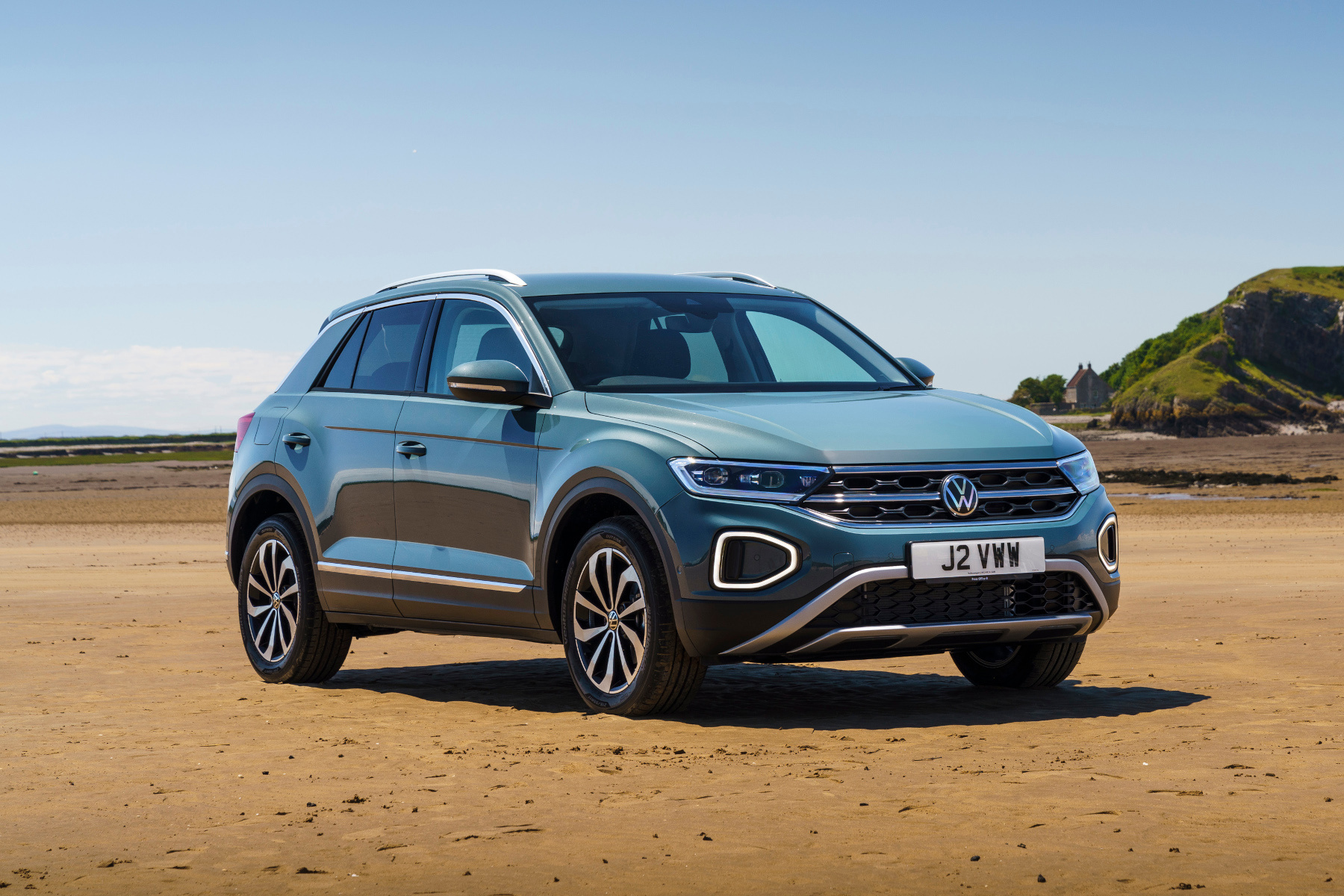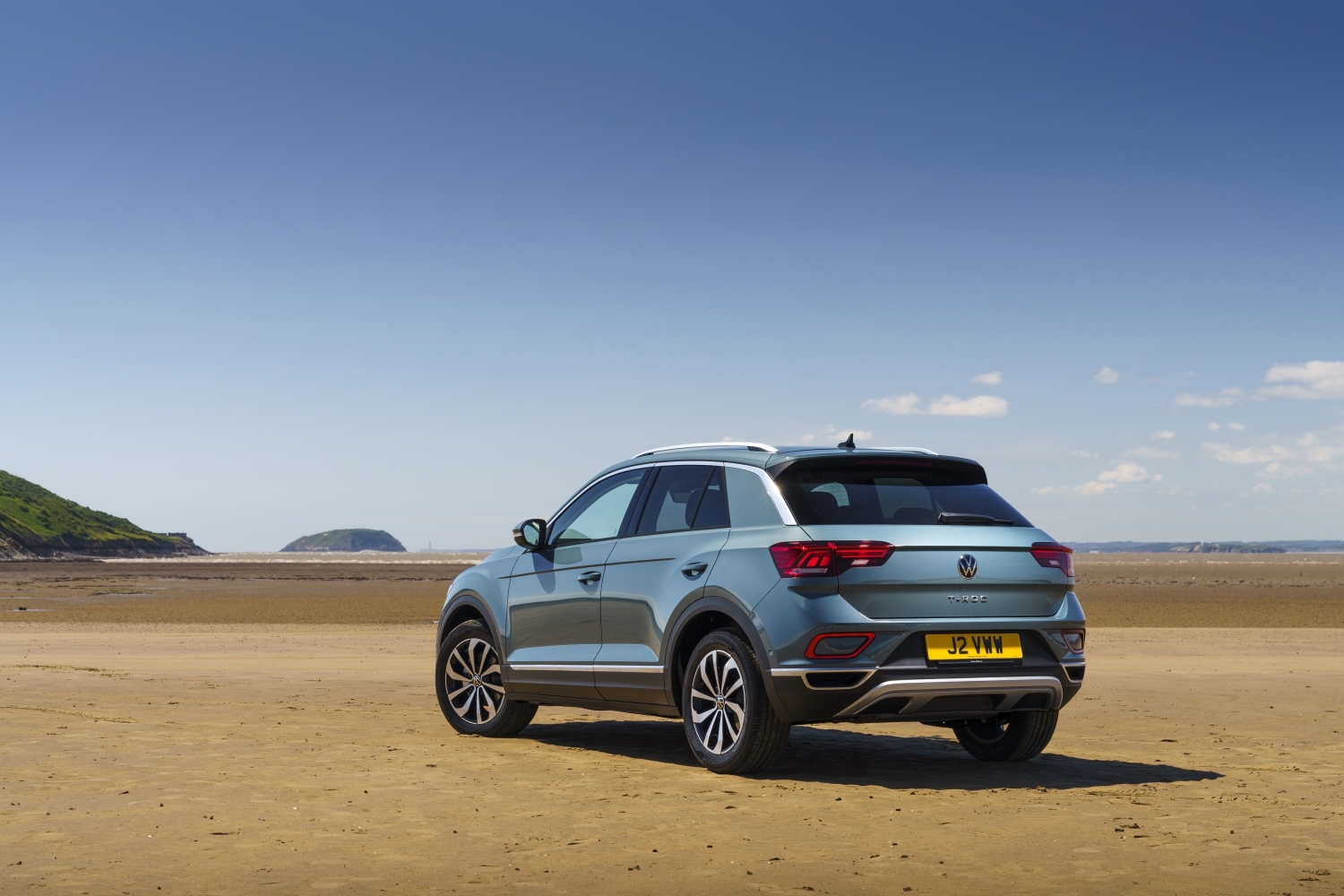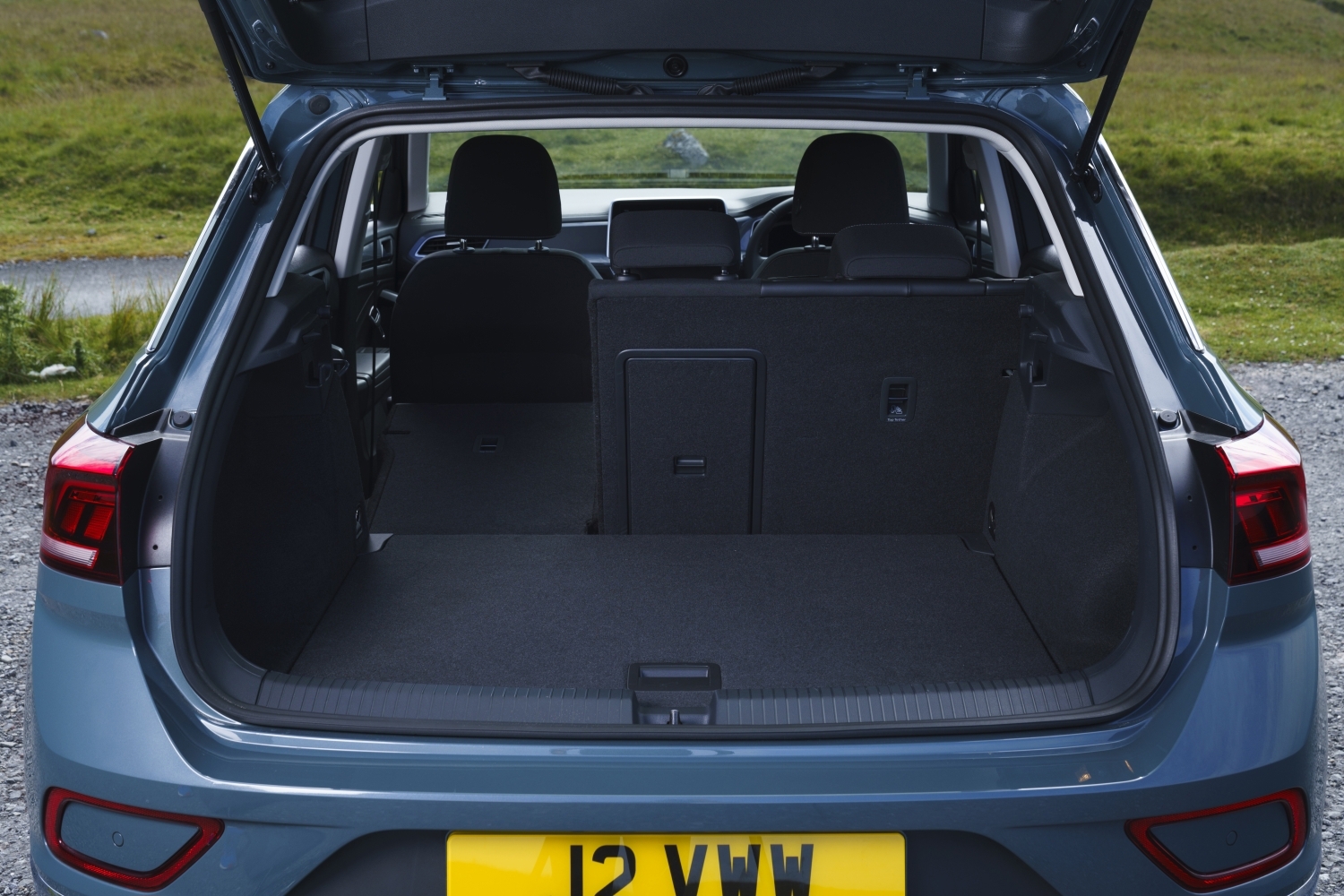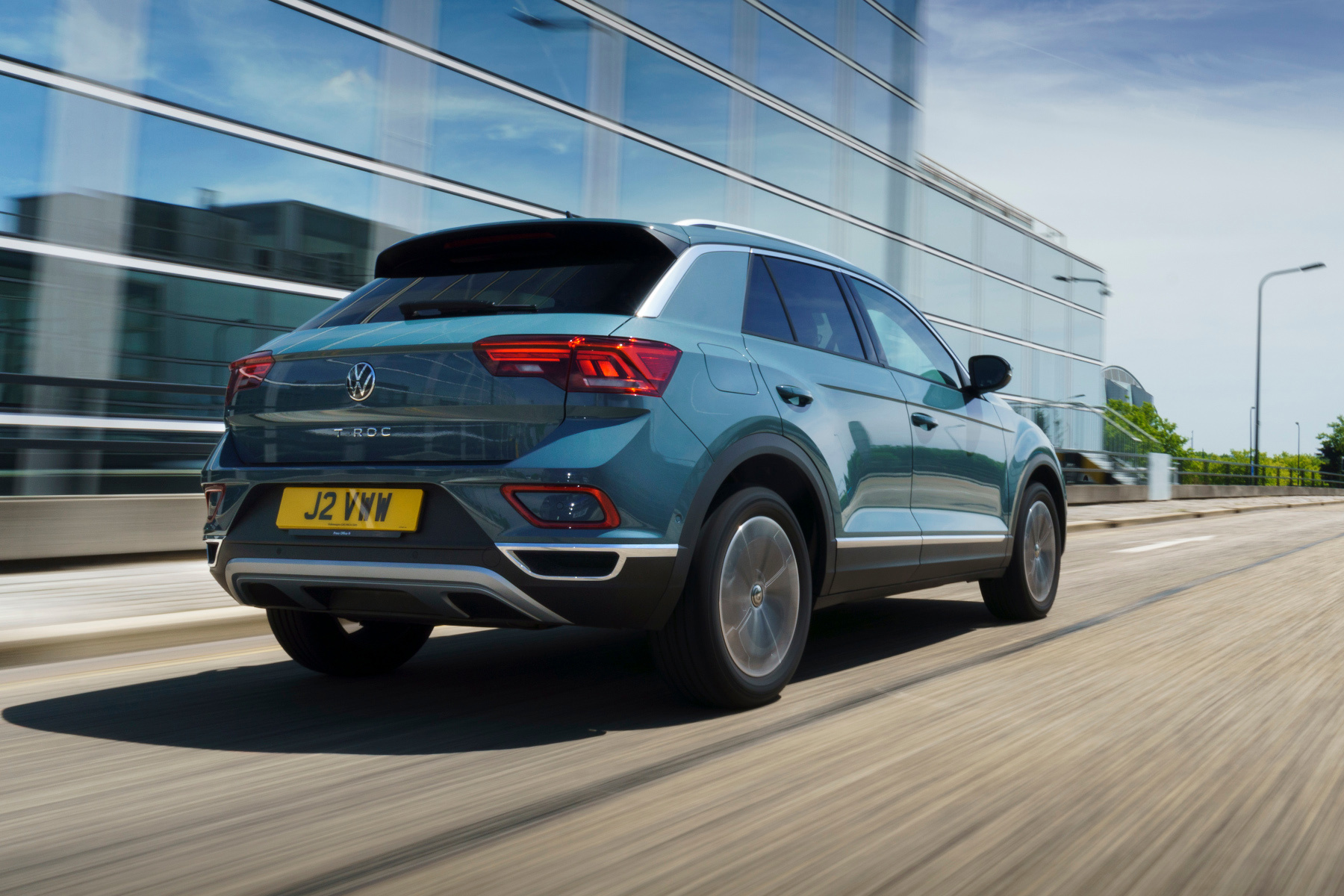Quick overview
- High driving position
- Comfort
- Versatile
- 4WD makes it pricey
- Not as good to drive as Ford Puma
- No hybrid
Volkswagen has an SUV for every occasion and niche, and the T-Roc is a key model in this bid to satisfy every driver’s desires. The size of the T-Roc means it comes into contention with many of the big hitters in the sector, from the Ford Puma and SEAT Arona to the Audi Q3 and MINI Countryman, plus everything in between. This could make it tricky to identify exactly where the T-Roc fits in to the VW line-up, especially when the company offers the Taigo and Tiguan plus the T-Cross that all sit within the same sort of sphere. However, the T-Roc has had no trouble in attracting plenty of drivers thanks to its long list of positives.
Prime among these are its clean, handsome looks plus that all-essential raised seating position for the driver that so many choose an SUV for. It also makes the T-Roc a very comfortable car to spend lots of time in, so it works as a family’s only car if that’s what you need. This is underscored by the T-Roc’s roomy rear cabin, large boot and good versatility. It all adds up to a car you don’t have to think about or adapt to for it to fit into your daily routine.
This is also true of the engine line-up with the T-Roc. Volkswagen doesn’t offer any hybrid power or an EV version of the model, which is an oversight in this day and age, but there is a wide selection of petrol and diesel engines. The petrols range from the expected 1.0- and 1.5-litre engines used in so many VWs to the more potent 2.0-litre turbo petrol that comes with four-wheel drive. This does have an impact on fuel economy, though, so you really will have to need this version to choose it. While other car makers are abandoning diesel, VW sticks with it with its range of 2.0-litre engines in a couple of power outputs, and you can also have four-wheel drive for those who might be towing a caravan or trailer regularly. There’s even the sensationally quick R version with 300hp that gives serious performance cars much to think about.
An update in 2022 brought improvements to the T-Roc’s quality and dash design, including a revised infotainment set-up, so it remains a compact SUV you must consider seriously.
Infotainment, comfort and practicality
One of the most notable features of the Volkswagen T-Roc is the driving position it provides. Where most of its rivals feel more like a hatchback from the driver’s seat, the T-Roc is definitely an SUV in the way it elevates the driver to offer a good view forward and to the sides. The front windscreen pillars are quite thick and chunky, so you do sometimes have to peer around them when pulling out of junctions, but it’s no worse than many others in this sector. The seat itself is very supportive and there’s standard height and lumbar adjustment for all T-Roc models. Vision for the driver out of the back the T-Roc is a bit limited, but every version comes with front and rear parking sensors as part of the Park Assist pack. You also get lane keeping assistance on all models.
The main dials in the T-Roc are clear and easily legible in the entry-level Life trim, while the upper three trim models come with VW’s 10.25-inch Digital Cockpit that replaces the normal dials with a screen that can be configured using the steering wheel buttons. It’s one of the best of its type and is easy to operate. VW also makes it easy to adjust the air conditioning settings with a separate control panel for this in the centre console, though it uses a smooth touch-sensitive panel rather than physical buttons that you find in a Skoda Karoq. Above this sits the 8.0-inch infotainment screen that’s used in all T-Roc models. It’s positioned high up so it’s easy to see and reach, and the operation is better than many others in this class such as the Peugeot 3008’s. VW sticks with proper dials to work the stereo’s volume and radio station choice, and the screen itself responds quickly to inputs. It also has a crisp resolution.
Head into the back of the T-Roc and you find one of the best in the business among mid-sized SUVs for passenger space. There is more than ample room for legs, heads, feet and shoulders. IF you choose the optional panoramic sunroof, a little headroom is sacrificed, but not as much as in some of the R-Roc’s competitors. You can fit three adults into the back as the VW is broader than most others in the segment, while kids will enjoy the space. There are also two Isofix child seat mounts in the outer two chairs, while storage is taken care of by map pockets and reasonably sized door bins.
The T-Roc’s rear seat is divided 40-20-40, so you have more options when it comes to fitting in loads alongside passengers. There’s no sliding or tilting function for the rear seats, but that’s not a major hurdle for the T-Roc as it comes with a generous 445-litres of boot capacity with the seats in place. Fold them all down and you free up a total of 1532-litres, which should be more than enough for most needs. All T-Roc versions have an adjustable height boot floor and, in its higher setting, it sits flush with the load sill.
2018 Volkswagen T-Roc engines: how does it drive?
There’s nothing if not variety in the Volkswagen T-Roc’s engine line-up. You don’t get the option of mild or plug-in hybrids and nor is there an EV version, but the turbocharged petrol and diesel motors offer something to suit almost everyone. It all starts with the three-cylinder 1.0-litre TSI engine with 110hp that features in so many VW models. In the T-Roc, it feels brisker and better than the on-paper stats might lead you to think as it has bags of low-down shove and it’s also a very refined engine when you’re up to motorway speed. It comes with a six-speed manual gearbox as its only transmission choice, so if you want an auto you’ll need to look further up the range to the 1.5-litre TSI with 150hp.
The 1.5 is the motor to have if you spend a lot of your driving life on the motorway as its added punch and power make it very flexible and relaxing to use. Its seven-speed DSG twin-clutch automatic gearbox makes it fractionally quicker over the 0-62mph sprint than it is with the six-speed manual ’box, but either works well on the open road or in town as the manual has a light, easy and accurate shift. Should you want to add four-wheel drive into the mix for your T-Roc, you’ll have to look to the 2.0-litre TSI petrol motor with 190hp that is only offered with the auto gearbox. It’s certainly got some zest to its performance and remains quiet when cruising at high speed, but its higher running costs would steer us in the direction of the 1.5 motor as the best all-round bet.
Then again, some will want the ultimate in their T-Roc and the comes in the R model with its 300hp 2.0-litre motor. This is every inch a serious performance car as it can dash off 0-62mph in just 4.9 seconds to put it on a par with many more obviously fast cars. It’s good fun to use and there’s just enough noise from the engine to let you know you’re in something special without it becoming intrusive. The R also has the DSG auto transmission and all-wheel drive, so it’s sure-footed and great fun to use on twisty roads.
The rest of the T-Roc’s engine options are diesels and based around VW’s trusty 2.0-litre TDI motor. It comes in 115- or 150hp forms, with the latter available with the DSH auto ’box and 4Motion four-wheel drive. In most instances, you’ll be fine with the front-drive models unless you live somewhere prone to bad weather or perhaps tow a caravan or trailer on a regular basis.
While the hard-charging R model is a rapid performance car, it still manages to make its way over crumpled tarmac without shaking its occupants about. There’s loads of grip and good steering feel, too, so it’s a very enjoyable car to drive even in more humdrum situations. The rest of the T-Roc range is very smooth and easy to use in town or on faster roads thanks to suspension that is more supple and accommodating than the likes of the MINI Countryman or Audi Q2. There’s a little more body lean with the VW than in these rivals, but you won’t feel queasy and top spec T-Roc models come wit Dynamic Chassis Control to let the driver choose how firm the suspension is. That said, it makes little real-world difference to how the T-Roc behaves, so you won’t miss it in models that do without it.
Value for money: how much does a 2018 Volkswagen T-Roc cost to buy and run?
Volkswagen starts off the T-Roc range with the Life trim, which costs from £26,080 with the 110hp 1.0-litre TSI engine. Go for the 1.5-litre engine and you pay from £27,555 for the manual and £29,240 for the auto. The only other engine offered with the life is less powerful 2.0-litre turbodiesel costing from £28,865. Next in line is the Style trim that has the full spread of engines and costs from £28,825, while the R-Line sticks with the more powerful engine options and its prices begin at £31,745. The standalone high performance R model weighs in at £42,155. Savings of around £1000 are perfectly feasible with brand-new T-Rocs, while nearly new models with only a few miles on the clock can be had from £23,500 depending on the trim, engine and gearbox you decide on. A three-year old T-Roc with around 30,000 miles under its wheels will cost from £17,000.
The Life version of the Volkswagen T-Roc gets things going and comes with 16-inch alloy wheels, lane assist, automatic headlights, automatic emergency braking, adaptive cruise control, and front and rear parking sensors. Inside, there’s climate air conditioning, front seats with lumbar adjustment, ambient lighting, and an 8.0-inch infotainment system with Apple CarPlay and Android Auto. Move up to the Style and you get 17-inch alloys, LED Plus headlights, silver roof rails in place of the Life’s black items, rear privacy glass, and the choice of the roof painted in body colour or a contrasting hue. The dash uses the 10.25-inch Digital Cockpit display, while the infotainment set-up gains sat-nav and wifi connection. With the R-Line trim, you have a different alloy wheel design, and there are unique bumpers for this model. It also has heated front seats, and the driving profile selection to choose between Normal, Sport, Eco and Individual settings. For the R, you benefit from 18-inch alloy wheels, R exterior styling that includes chromed twin exhausts, and there’s 4Motion four-wheel drive as standard. The interior has front sports seats and the R is trimmed in Karoso fabric and microfleece upholstery. On the steering wheel of the R, there are paddle shifters for the DSG gearbox.
Running costs for the Volkswagen T-Roc vary depending on your choice of engine, gearbox and if you want four-wheel drive. The 1.0-litre 110hp engine delivers a good 47.1mpg and 136g/km of carbon dioxide emissions. Choose the 1.5-litre 150hp turbo petrol and you’ll see the same fuel economy and slightly lower 135g/km emissions with the manual gearbox, while the auto offers 46.3mpg and 138g/km. The 2.0litre 190hp TSI engine comes with all-wheel drive and auto transmission as standard, which means you’re looking at a combined economy of 38.2mpg and 168g/km, while the R provides 33.2mpg and 194g/km. The diesels are the most frugal, with 60.1mpg and 122g/km from the 115hp version. The 150hp diesel gives 58.9mpg and 125g/km with the six-speed manual gearbox or 57.7mpg and 128g/km with the auto. Add four-wheel drive to the more powerful diesel and you end up 51.4mpg and 145g/km. Most T-Rocs fall into an insurance group somewhere between 15 and 27 dependent on which trim and engine you pick, while the R sits in group 34.
Verdict: Should I buy a 2018 Volkswagen T-Roc?
Volkswagen offers one of the very best cars in the smaller SUV segment with the T-Roc. It does pretty much everything well or exceedingly well, which makes it a very tough act for its rivals to the get the better of it. Sure, the Ford Puma or MINI Countryman are more entertaining to drive on a twisty country road, but then VW has the very rapid R version of the T-Roc if you want these kind of thrills.
Of more importance to most drivers will be the T-Roc’s roomy, well made and well-appointed cabin that is sufficiently versatile to work for most families. There’s loads of room in the front, back and boot, and all T-Roc models come with a long list of standard luxury and safety kit. The only real note of caution is if you choose the all-wheel drive versions as they take a dip in fuel economy.
What could I buy instead of a 2018 Volkswagen T-Roc?
MINI Countryman
.jpg?rmode=max&width=500)
Always keen to get into a niche and make the most of it, MINI did just that with its original Countryman and this latest version carries on this work. It offers drivers a slice of something that feels more upmarket than most of its rivals, though this does come at a price and you will almost certainly have to raid the options list to finish the car to your liking. It’s one of the few small SUVs to be truly fun and agile in the way it drives, but the MINI has a very firm ride that undermines it as a car for longer journeys.
Ford Puma
.jpg?rmode=max&width=500)
The Ford Puma has become the go-to small SUV for many drivers, and it’s easy to see why. The Puma is stylish, great to drive, affordable, and it’s practical too. The cabin is well put together and roomy, while the boot is simply huge once you get used to the idea of its extra underfloor space. It’s also available with hybrid power or as an ST hot hatch version. One of the Ford’s great strengths is its superb ride and body control, which put it well ahead of most in this sector in this respect.
Volvo XC40
.jpg?rmode=max&width=500)
Volvo has always gone its own way when designing cars and the XC40 is a prime example of this works in the Swede’s favour. For looks, the XC is one of the most stand-out cars in this sector, and this theme carries through to the chic, almost minimalist interior. There are just enough touches of style in here to raise it above the herd, yet it’s also practical and comfortable, if not the most spacious. There are petrol or hybrid power options, though confusingly the hybrid is called the same name as the pure EV model, which is also an expensive choice.
.jpg?rmode=max&width=500)









.jpg?rmode=max&width=500)
.jpg?rmode=max&width=500)